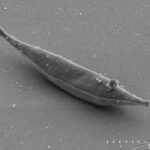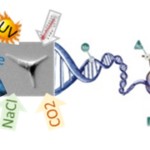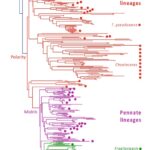
Udita CHANDOLA
Doctorante Université
juillet 2023
| Équipe : |
Projets
Parcours universitaire
* 2008-2011: Bachelor of Science (Université de Mumbai, Inde)
* 2011-2013: Master (Institute of Bioinformatics and Applied Biotechnology, Bangalore, Inde)
* 2019 – actuel : Thèse
Publications
2 publications
Chandola, Udita; Manirakiza, Eric; Maillard, Margaux; Lavier-Aydat, Louis-Josselin; Camuel, Alicia; Trottier, Camille; Tanaka, Astuko; Chaumier, Timothée; Giraud, Eric; Tirichine, Leila
A Bradyrhizobium isolate from a marine diatom induces nitrogen-fixing nodules in a terrestrial legume Article de journal
Dans: Nature Microbiology, 2025.
@article{Chandola2025,
title = {A Bradyrhizobium isolate from a marine diatom induces nitrogen-fixing nodules in a terrestrial legume},
author = {Udita Chandola and Eric Manirakiza and Margaux Maillard and Louis-Josselin Lavier-Aydat and Alicia Camuel and Camille Trottier and Astuko Tanaka and Timothée Chaumier and Eric Giraud and Leila Tirichine},
editor = {Nature},
doi = {10.1038/s41564-025-02105-5},
year = {2025},
date = {2025-09-05},
journal = {Nature Microbiology},
abstract = {Biological nitrogen fixation converts atmospheric nitrogen into ammonia, essential to the global nitrogen cycle. While cyanobacterial diazotrophs are well characterized, recent studies have revealed a broad distribution of non-cyanobacterial diazotrophs (NCDs) in marine environments, although their study is limited by poor cultivability. Here we report a previously uncharacterized Bradyrhizobium isolated from the marine diatom Phaeodactylum tricornutum. Phylogenomic analysis places the strain within photosynthetic Bradyrhizobium, suggesting evolutionary adaptations to marine and terrestrial niches. Average nucleotide identity supports its classification as a previously undescribed species. Remarkably, inoculation experiments showed that the isolate induced nitrogen-fixing nodules in the Aeschynomene indica legume, pointing to symbiotic capabilities across ecological boundaries. Pangenome analysis and metabolic predictions indicate that this isolate shares more features with terrestrial photosynthetic Bradyrhizobium than with marine NCDs. Overall, these findings suggest that symbiotic interactions could evolve across different ecological niches, and raise questions about the evolution of nitrogen fixation and microbe–host interactions.},
keywords = {},
pubstate = {published},
tppubtype = {article}
}
Chandola, Udita; Gaudin, Marinna; Trottier, Camille; Lavier-Aydat, Louis-Josselin; Manirakiza, Eric; Menicot, Samuel; Fischer, Erik Jörg; Louvet, Isabelle; Lacour, Thomas; Chaumier, Timothée; Tanaka, Atsuko; Pohnert, Georg; Chaffron, Samuel; Tirichine, Leïla
Non-cyanobacterial diazotrophs support the survival of marine microalgae in nitrogen-depleted environment Article de journal
Dans: Genome Biology, 2025.
@article{nokey,
title = {Non-cyanobacterial diazotrophs support the survival of marine microalgae in nitrogen-depleted environment },
author = {Udita Chandola and Marinna Gaudin and Camille Trottier and Louis-Josselin Lavier-Aydat and Eric Manirakiza and Samuel Menicot and Erik Jörg Fischer and Isabelle Louvet and Thomas Lacour and Timothée Chaumier and Atsuko Tanaka and Georg Pohnert and Samuel Chaffron and Leïla Tirichine},
doi = {10.1186/s13059-025-03597-4},
year = {2025},
date = {2025-05-15},
urldate = {2025-05-15},
journal = {Genome Biology},
keywords = {},
pubstate = {published},
tppubtype = {article}
}
1 publication
Timothée, Chaumier; Yang, Feng; Manirakiza, Eric; Ait-Mohamed, Ouardia; Wu, Yue; Chandola, Udita; Jesus, Bruno; Piganeau, Gwenael; Groisillier, Agnès; Tirichine, Leila
Genome-wide assessment of genetic diversity and transcript variations in 17 accessions of the model diatom Phaeodactylum tricornutum Article de journal
Dans: ISME Communications, vol. 4, iss. 1, p. ycad008, 2024.
@article{Timothée2024,
title = {Genome-wide assessment of genetic diversity and transcript variations in 17 accessions of the model diatom Phaeodactylum tricornutum},
author = {Chaumier Timothée and Feng Yang and Eric Manirakiza and Ouardia Ait-Mohamed and Yue Wu and Udita Chandola and Bruno Jesus and Gwenael Piganeau and Agnès Groisillier and Leila Tirichine},
url = {https://www.ncbi.nlm.nih.gov/pmc/articles/PMC10833087/},
doi = {10.1093/ismeco/ycad008},
year = {2024},
date = {2024-01-10},
urldate = {2024-01-10},
journal = {ISME Communications},
volume = {4},
issue = {1},
pages = {ycad008},
abstract = {Diatoms, a prominent group of phytoplankton, have a significant impact on both the oceanic food chain and carbon sequestration, thereby playing a crucial role in regulating the climate. These highly diverse organisms show a wide geographic distribution across various latitudes. In addition to their ecological significance, diatoms represent a vital source of bioactive compounds that are widely used in biotechnology applications. In the present study, we investigated the genetic and transcriptomic diversity of 17 accessions of the model diatom Phaeodactylum tricornutum including those sampled a century ago as well as more recently collected accessions. The analysis of the data reveals a higher genetic diversity and the emergence of novel clades, indicating an increasing diversity within the P. tricornutum population structure, compared to the previous study and a persistent long-term balancing selection of genes in old and newly sampled accessions. However, the study did not establish a clear link between the year of sampling and genetic diversity, thereby, rejecting the hypothesis of loss of heterozygoty in cultured strains. Transcript analysis identified novel transcript including noncoding RNA and other categories of small RNA such as PiwiRNAs. Additionally, transcripts analysis using differential expression as well as Weighted Gene Correlation Network Analysis has provided evidence that the suppression or downregulation of genes cannot be solely attributed to loss-of-function mutations. This implies that other contributing factors, such as epigenetic modifications, may play a crucial role in regulating gene expression. Our study provides novel genetic resources, which are now accessible through the platform PhaeoEpiview (https://PhaeoEpiView.univ-nantes.fr), that offer both ease of use and advanced tools to further investigate microalgae biology and ecology, consequently enriching our current understanding of these organisms.},
keywords = {},
pubstate = {published},
tppubtype = {article}
}
1 publication
Chandola, Udita; Trottier, Camille; Gaudin, Marinna; Manirakiza, Erik; Menicot, Samuel; Louvet, Isabelle; Lacour, Thomas; Chaumier, Timothée; Tanaka, Atsuko; Chaffron, Samuel; Tirichine, Leila
Combined in vivo and in situ genome-resolved metagenomics reveals novel symbiotic nitrogen fixing interactions between non-cyanobacterial diazotrophs and microalgae Article de journal À paraître
Dans: bioRxiv, À paraître.
@article{Chandola2022.08.25.505241,
title = {Combined in vivo and in situ genome-resolved metagenomics reveals novel symbiotic nitrogen fixing interactions between non-cyanobacterial diazotrophs and microalgae},
author = {Udita Chandola and Camille Trottier and Marinna Gaudin and Erik Manirakiza and Samuel Menicot and Isabelle Louvet and Thomas Lacour and Timothée Chaumier and Atsuko Tanaka and Samuel Chaffron and Leila Tirichine},
url = {https://www.biorxiv.org/content/early/2022/08/25/2022.08.25.505241},
doi = {10.1101/2022.08.25.505241},
year = {2022},
date = {2022-08-25},
urldate = {2022-08-25},
journal = {bioRxiv},
publisher = {Cold Spring Harbor Laboratory},
abstract = {Non-cyanobacteria diazotrophs (NCDs) were shown to dominate in surface waters shifting the long-held paradigm of cyanobacteria dominance and raising fundamental questions on how these putative heterotrophic bacteria thrive in sunlit oceans. Here, we report an unprecedented finding in the widely used model diatom Phaeodactylum triconrnutum (Pt) of NCDs sustaining diatom cells in the absence of bioavailable nitrogen. We identified PtNCDs using metagenomics sequencing and detected nitrogenase gene in silico and/or by PCR. We demonstrated nitrogen fixation in PtNCDs and their close genetic affiliation with NCDs from the environment. We showed the wide occurrence of this type of symbiosis with the isolation of NCDs from other microalgae and their identification in the environment and in co-occurrence with photosynthetic microalgae. Overall, this study provides evidence for a previously overlooked symbiosis using a multidisciplinary model-based approach which will consequently help understand the different players driving global marine nitrogen fixation.Competing Interest StatementThe authors have declared no competing interest.},
keywords = {},
pubstate = {forthcoming},
tppubtype = {article}
}
2018
Palve, Vinayak; Bagwan, Jamir; Krishnan, Neeraja M; Pareek, Manisha; Chandola, Udita; Suresh, Amritha; Siddappa, Gangotri; James, Bonney L; Kekatpure, Vikram; Kuriakose, Moni Abraham; others,
Detection of high-risk human papillomavirus in oral cavity squamous cell carcinoma using multiple analytes and their role in patient survival Article de journal
Dans: Journal of global oncology, vol. 4, p. 1–33, 2018.
@article{palve2018detection,
title = {Detection of high-risk human papillomavirus in oral cavity squamous cell carcinoma using multiple analytes and their role in patient survival},
author = {Vinayak Palve and Jamir Bagwan and Neeraja M Krishnan and Manisha Pareek and Udita Chandola and Amritha Suresh and Gangotri Siddappa and Bonney L James and Vikram Kekatpure and Moni Abraham Kuriakose and others},
doi = {10.1200/JGO.18.00058},
year = {2018},
date = {2018-01-01},
journal = {Journal of global oncology},
volume = {4},
pages = {1--33},
publisher = {American Society of Clinical Oncology},
abstract = {Purpose. Accurate detection of human papillomavirus (HPV) in oral cavity squamous cell carcinoma (OSCC) is essential to understanding the role of HPV in disease prognosis and management of patients. We used different analytes and methods to understand the true prevalence of HPV in a cohort of patients with OSCC with different molecular backgrounds, and we correlated HPV data with patient survival.
Methods. We integrated data from multiple analytes (HPV DNA, HPV RNA, and p16), assays (immunohistochemistry, polymerase chain reaction [PCR], quantitative PCR [qPCR], and digital PCR), and molecular changes (somatic mutations and DNA methylation) from 153 patients with OSCC to correlate p16 expression, HPV DNA, and HPV RNA with HPV incidence and patient survival.
Results. High prevalence (33% to 58%) of HPV16/18 DNA did not correlate with the presence of transcriptionally active viral genomes (15%) in tumors. Eighteen percent of the tumors were p16 positive and only 6% were both HPV DNA and HPV RNA positive. Most tumors with relatively high copy number HPV DNA and/or HPV RNA, but not with HPV DNA alone (irrespective of copy number), were wild-type for TP53 and CASP8 genes. In our study, p16 protein, HPV DNA, and HPV RNA, either alone or in combination, did not correlate with patient survival. Nine HPV-associated genes stratified the virus-positive from the virus-negative tumor group with high confidence (P < .008) when HPV DNA copy number and/or HPV RNA were considered to define HPV positivity, and not HPV DNA alone, irrespective of copy number (P < .2).
Conclusion. In OSCC, the presence of both HPV RNA and p16 is rare. HPV DNA alone is not an accurate measure of HPV positivity and therefore may not be informative. HPV DNA, HPV RNA, and p16 do not correlate with patients’ outcome.},
keywords = {},
pubstate = {published},
tppubtype = {article}
}
Methods. We integrated data from multiple analytes (HPV DNA, HPV RNA, and p16), assays (immunohistochemistry, polymerase chain reaction [PCR], quantitative PCR [qPCR], and digital PCR), and molecular changes (somatic mutations and DNA methylation) from 153 patients with OSCC to correlate p16 expression, HPV DNA, and HPV RNA with HPV incidence and patient survival.
Results. High prevalence (33% to 58%) of HPV16/18 DNA did not correlate with the presence of transcriptionally active viral genomes (15%) in tumors. Eighteen percent of the tumors were p16 positive and only 6% were both HPV DNA and HPV RNA positive. Most tumors with relatively high copy number HPV DNA and/or HPV RNA, but not with HPV DNA alone (irrespective of copy number), were wild-type for TP53 and CASP8 genes. In our study, p16 protein, HPV DNA, and HPV RNA, either alone or in combination, did not correlate with patient survival. Nine HPV-associated genes stratified the virus-positive from the virus-negative tumor group with high confidence (P < .008) when HPV DNA copy number and/or HPV RNA were considered to define HPV positivity, and not HPV DNA alone, irrespective of copy number (P < .2).
Conclusion. In OSCC, the presence of both HPV RNA and p16 is rare. HPV DNA alone is not an accurate measure of HPV positivity and therefore may not be informative. HPV DNA, HPV RNA, and p16 do not correlate with patients’ outcome.
Li, Wei; Hong, Ru; Lai, Lan-Tian; Dong, Qiman; Ni, Peiling; Chelliah, Rosi; Huq, Mehnaz; Ismail, Siti Nadirah Binte; Chandola, Udita; Ang, Zhiwei; others,
Genome-Wide RNAi Screen Identify Melanoma-Associated Antigen Mageb3 Involved in X Chromosome Inactivation Article de journal
Dans: Journal of molecular biology, vol. 430, no. 17, p. 2734–2746, 2018.
@article{li2018genome,
title = {Genome-Wide RNAi Screen Identify Melanoma-Associated Antigen Mageb3 Involved in X Chromosome Inactivation},
author = {Wei Li and Ru Hong and Lan-Tian Lai and Qiman Dong and Peiling Ni and Rosi Chelliah and Mehnaz Huq and Siti Nadirah Binte Ismail and Udita Chandola and Zhiwei Ang and others},
doi = {10.1016/j.jmb.2018.05.031},
year = {2018},
date = {2018-01-01},
journal = {Journal of molecular biology},
volume = {430},
number = {17},
pages = {2734--2746},
publisher = {Elsevier},
abstract = {Xist (inactivated X chromosome specific transcript) is a prototype long noncoding RNA in charge of epigenetic silencing of one X chromosome in each female cell in mammals. In a genetic screen, we identify Mageb3 and its homologs Mageb1 and Mageb2 as genes functionally required for Xist-mediated gene silencing. Mageb1–3 are previously uncharacterized genes belonging to the MAGE (melanoma-associated antigen) gene family. Mageb1–3 are expressed in undifferentiated ES cells and early stages of in vitro differentiation, a critical time window of X chromosome inactivation. Mageb3 showed both cytoplasmic and nuclear localization without enrichment on the inactive X (Xi). Mageb3 interacted with Polycomb group ring finger 3 (Pcgf3), a RING finger protein involved in recruiting Polycomb activities onto Xi. Mageb3 overexpression stabilized Pcgf3 protein. Mageb1–3 gene knockout affected H3K27me3 enrichment and the spreading of gene silencing along Xi. These data suggested that Mageb3 might regulate the recruitment of the Polycomb complex onto Xi and subsequent H3K27me3 modification through Pcgf3. Moreover, the nucleolar enrichment of Mageb3 was diminished when nuclear matrix factor hnRNP U is overexpressed, implying the interaction between Mageb3 and nuclear matrix, which is another possible mechanism for Mageb3 to regulate X chromosome inactivation.},
keywords = {},
pubstate = {published},
tppubtype = {article}
}
2017
Hong, Ru; Chandola, Udita; Zhang, Li-Feng
Cat-D: a targeted sequencing method for the simultaneous detection of small DNA mutations and large DNA deletions with flexible boundaries Article de journal
Dans: Scientific reports, vol. 7, no. 1, p. 1–8, 2017.
@article{hong2017cat,
title = {Cat-D: a targeted sequencing method for the simultaneous detection of small DNA mutations and large DNA deletions with flexible boundaries},
author = {Ru Hong and Udita Chandola and Li-Feng Zhang},
doi = {10.1038/s41598-017-15764-0},
year = {2017},
date = {2017-01-01},
journal = {Scientific reports},
volume = {7},
number = {1},
pages = {1--8},
publisher = {Nature Publishing Group},
abstract = {We developed a targeted DNA sequencing method that is capable of detecting a comprehensive panel of DNA mutations including small DNA mutations and large DNA deletions with unknown/flexible boundaries. The method directly identifies the large DNA deletions (Cat-D) without relying on sequencing coverage to make the genotype calls. We performed the method to simultaneously detect 10 small DNA mutations in β-thalassemia and 2 large genomic deletions in α-thalassemia from 10 genomic DNA samples. Cat-D was performed on 8 genomic DNA samples in duplicate. The 18 Cat-D samples were combined in one sequencing run. In total, 216 genotype calls were made, and 215 of the genotype calls were accurate. No false negative genotype calls were made. One false positive genotype call was made on one target mutation in one experimental duplicate from a genomic DNA sample. In summary, Cat-D can be developed into a robust, high-throughput and cost-effective method suitable for population-based carrier screens.},
keywords = {},
pubstate = {published},
tppubtype = {article}
}
2015
Chandola, Udita; Das, Radhika; Panda, Binay
Role of the N6-methyladenosine RNA mark in gene regulation and its implications on development and disease Article de journal
Dans: Briefings in functional genomics, vol. 14, no. 3, p. 169–179, 2015.
@article{chandola2015role,
title = {Role of the N6-methyladenosine RNA mark in gene regulation and its implications on development and disease},
author = {Udita Chandola and Radhika Das and Binay Panda},
doi = {https://doi.org/10.1093/bfgp/elu039},
year = {2015},
date = {2015-01-01},
journal = {Briefings in functional genomics},
volume = {14},
number = {3},
pages = {169--179},
publisher = {Oxford University Press},
abstract = {Epigenetics is a field that encompasses chemical modifications of DNA and histone proteins, both of which alter gene expression without changing the underlying nucleotide sequence. DNA methylation and modifications of histone tails have been studied in detail and are now known to be global gene regulatory mechanisms. An analogous post-transcriptional modification is chemical modification of specific nucleotides in RNA. Study of RNA modifications is a nascent field as yet, and the significance of these marks in controlling cell growth and differentiation is just beginning to be appreciated. The addition of a methyl group to adenosine (N-methyl-6-adenosine) or m6A is the most abundant modification in mammalian mRNAs. Though identified four decades ago, interest in this particular modification was set off by the discovery that the obesity gene FTO was an RNA demethylase. Since then, many studies have investigated m6A modification in different species. In this review, we summarize the current literature and hypotheses about the presence and function of this ubiquitous RNA modification in mammals, viruses, yeast and plants in terms of the consensus sequence and the methyltransferase/demethylation machinery identified thus far. We discuss its potential role in regulating molecular and physiological processes in each of these organisms, especially its role in RNA splicing, RNA degradation and development. We also enlist the methodologies developed so far, both locus-specific and transcriptome-wide, to study this modification. Lastly, we discuss whether m6A alterations have consequences on modulating disease aetiology, and speculate about its potential role in cancer.},
keywords = {},
pubstate = {published},
tppubtype = {article}
}
Nair, Jayalakshmi; Jain, Prachi; Chandola, Udita; Palve, Vinayak; Vardhan, Harsha N R; Reddy, Ram Bhupal; Kekatpure, Vikram D; Suresh, Amritha; Kuriakose, Moni Abraham; Panda, Binay
Gene and miRNA expression changes in squamous cell carcinoma of larynx and hypopharynx Article de journal
Dans: Genes & cancer, vol. 6, no. 7-8, p. 328, 2015.
@article{nair2015gene,
title = {Gene and miRNA expression changes in squamous cell carcinoma of larynx and hypopharynx},
author = {Jayalakshmi Nair and Prachi Jain and Udita Chandola and Vinayak Palve and Harsha N R Vardhan and Ram Bhupal Reddy and Vikram D Kekatpure and Amritha Suresh and Moni Abraham Kuriakose and Binay Panda},
doi = {10.18632/genesandcancer.69},
year = {2015},
date = {2015-01-01},
journal = {Genes & cancer},
volume = {6},
number = {7-8},
pages = {328},
publisher = {Impact Journals, LLC},
abstract = {Laryngo-pharyngeal squamous cell carcinomas are one of the most common head and neck cancers. Despite the presence of a large body of information, molecular biomarkers are not currently used in the diagnosis, treatment and management of patients for this group of cancer. Here, we have profiled expression of genes and microRNAs of larynx and hypopharynx tumors using high-throughput sequencing experiments. We found that matrix metalloproteinases along with SCEL, CRNN, KRT4, SPINK5, and TGM3 among others have significantly altered expression in these tumors. Alongside gene expression, the microRNAs hsa-miR-139, hsa-miR-203 and the hsa-miR-424/503 cluster have aberrant expression in these cancers. Using target genes for these microRNAs, we found the involvement of pathways linked to cell cycle, p53 signaling, and viral carcinogenesis significant (P-values 10−13, 10−9 and 10−7 respectively). Finally, using an ensemble machine-learning tool, we discovered a unique 8-gene signature for this group of cancers that differentiates the group from the other tumor subsites of head and neck region. We investigated the role of promoter methylation in one of these genes, WIF1, and found no correlation between DNA methylation and down-regulation of WIF1. We validated our findings of gene expression, 8-gene signature and promoter methylation using q-PCR, data from TCGA and q-MSP respectively.
Data presented in this manuscript has been submitted to the NCBI Geo database with the accession number GSE67994.},
keywords = {},
pubstate = {published},
tppubtype = {article}
}
Data presented in this manuscript has been submitted to the NCBI Geo database with the accession number GSE67994.


